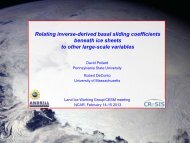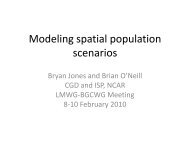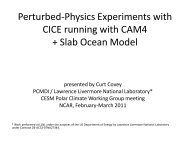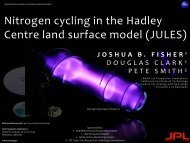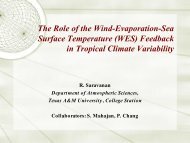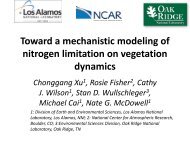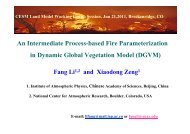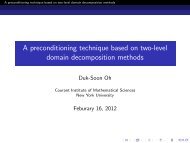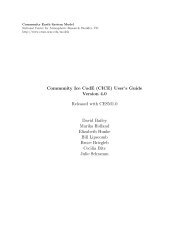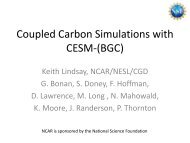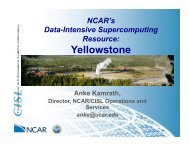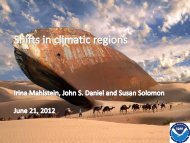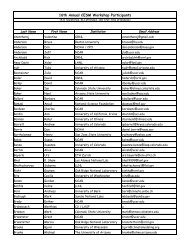Anticipated Changes for CAM4 Part 1 - CESM
Anticipated Changes for CAM4 Part 1 - CESM
Anticipated Changes for CAM4 Part 1 - CESM
Create successful ePaper yourself
Turn your PDF publications into a flip-book with our unique Google optimized e-Paper software.
CAM 4 Update<br />
Phil Rasch<br />
• CAM3.5, almost done<br />
• Inclusion of new aerosol distributions<br />
• Tuning <strong>for</strong> 1870.<br />
• Hindcast to see transient simulation character<br />
• First hints at climate sensitivity!<br />
• The parameterizations that are in CAM3.5<br />
may not be in <strong>CAM4</strong>!<br />
• Post CAM3.5 already developing very rapidly
• <strong>Part</strong> 1: Briefing on<br />
•<br />
Outline of presentation<br />
• revisions that are “almost ready”<br />
• advances that are a bit less certain but still likely<br />
• A mention of things in which progress is “murky”<br />
<strong>Part</strong> 2: A mention of topics of interest to AMWG<br />
–<br />
–<br />
–<br />
Peter Hess<br />
Andrew Gettelman<br />
Jim Hack
Parameterizations that are maturing and ready <strong>for</strong><br />
group assessment!<br />
• Aerosol <strong>for</strong>mulation: (in collaboration with Chem/Climate WG)<br />
– merger of CGD & ACD bulk aerosol <strong>for</strong>mulation<br />
(these aerosols will be used <strong>for</strong> transient simulations with<br />
CCSM3.5). This is an interim solution, pending successful<br />
integration of PNNL codes (Liu/Ghan hope <strong>for</strong> first<br />
implementation in 4-8 weeks)!<br />
– Complete the integration with new microphysics & Ghan<br />
droplet activation<br />
• Formal Assessment of UW PBL and Shallow convection schemes<br />
• Formal Assessment of Morrison/Gettelman microphysics<br />
• Formal Assessment of gravity wave and orographic wave<br />
breaking <strong>for</strong>mulations<br />
• Formal Assessment of Hybrid Isentropic coordinates
New Aerosols<br />
(Hess, Rasch, Mahowald, Barth, Bond, Bundy, Vitt)
•<br />
•<br />
•<br />
UW PBL and Shallow<br />
Convection<br />
(Bretherton & Park) Park) <br />
New physics<br />
More realistic<br />
Remove previous<br />
parameterizations<br />
dependence on vertical<br />
resolution<br />
Control UW
Stratocumulus regime (Physics terms) terms) <br />
Control<br />
CAM-UW<br />
PBL<br />
tendency<br />
Shallow<br />
tendency<br />
Prognostics cloud<br />
water tendency
UW Parameterization<br />
PBL Height Change
Notice these<br />
features!<br />
UW Parameterization<br />
Low Cloud Fraction
Notice these<br />
features!<br />
UW Parameterization<br />
Shortwave Cloud Forcing Change
UW Parameterization<br />
Net Heat Flux change
UW Parameterization<br />
Surface Stress
UW Parameterization<br />
Surface Temperature Change
•<br />
•<br />
•<br />
Taylor Diagram new model vs CAM3.5<br />
Perhaps one more minor<br />
tuning then time <strong>for</strong> a<br />
coupled run!<br />
(Feedback from CCSM<br />
community)<br />
Further improvements<br />
at least within the PBL<br />
scheme are likely during<br />
the summer!<br />
–<br />
Svensson, Holtslog,
•<br />
•<br />
•<br />
New microphysics<br />
(Morrison, Gettelman, Ghan) Ghan) <br />
predicts drop number<br />
– with cloud drop activation provides<br />
(indirect effect)<br />
– Capability <strong>for</strong> indirect effect is a blessing and<br />
curse!<br />
modern representation of microphysics<br />
– Including mixed phase processes<br />
More realistic<br />
control<br />
retrieval<br />
new<br />
Indirect effects of aerosols in CAM:<br />
PDF of N. Hemisphere (20-80N)<br />
Effective Radius of Liquid Cloud<br />
Drops <strong>for</strong> Present day and Preindustrial<br />
Aerosol Loading at<br />
~850hPa
New Hybrid Terrain<br />
following/isentropic<br />
(Chen & Rasch) Rasch<br />
Diff<br />
Control<br />
Vs<br />
ERA<br />
Diff<br />
New<br />
Model<br />
Vs<br />
Control<br />
•<br />
Removes known computational<br />
artifacts in sigma coordinate<br />
models<br />
• Significant reduction in a<br />
systematic bias present in 22 of<br />
Zonal average<br />
23 models in IPCC AR4<br />
temperature<br />
DJF JJA
Ann Avg Temperature<br />
diff vs ERA15<br />
T42-ERA FV-ERA IFV-ERA
•<br />
Hybrid Isentropic <strong>for</strong>mulation<br />
Reduces other<br />
problems as well<br />
–<br />
–<br />
–<br />
–<br />
–<br />
Reduce Water vapor in<br />
UTLS<br />
Increase it in middle<br />
troposphere (less mixing)<br />
Clouds<br />
Transport in UTLS region<br />
Surface Pressure patterns<br />
(see next slide)
•<br />
Isentropic Coords (continued)<br />
Substantial changes to<br />
–<br />
–<br />
–<br />
Surface pressure biases<br />
Stationary waves<br />
Zonal wind<br />
Control Obs<br />
Isentropic<br />
model
•<br />
Substantial changes to<br />
–<br />
–<br />
–<br />
<strong>Changes</strong> to Mountain drag<br />
(Sassi and Boville)<br />
Surface pressure biases<br />
Stationary waves<br />
Zonal wind<br />
Control<br />
Obs<br />
Mountain<br />
Drag
•<br />
•<br />
So….. So ..<br />
How carefully do we tune prior to putting<br />
these 5 parameterizations together?<br />
My vote is to not tune individual stages too<br />
carefully! Every “n”<br />
steps push model back<br />
to real world, and then do a coupled run.
Next Steps<br />
(likely changes, but final outcome uncertain) uncertain <br />
• Explore horizontal and vertical resolution sensitivities<br />
• Improved ice, (Morrison, Gettelman, Mitchell, Liu)<br />
• Ghan aerosol <strong>for</strong>mulation desirable, interim aerosol<br />
solution (by Rasch, Mahowald, Hess, Barth, Bond) is the<br />
backup<br />
• Radiation<br />
– AER RRTM<br />
– BUGSrad<br />
– ??
Next Steps (very uncertain) uncertain) <br />
• subgridscale water variability -> Cloud Fraction<br />
– sub-column generator<br />
– radiation --> heating & photolysis<br />
– microphysics<br />
• alternate deep convection schemes<br />
• Bretherton shallow -> Deep<br />
• More variations on ZM?<br />
• Emanuel
•<br />
•<br />
•<br />
Summary<br />
It is very likely that this version of CAM will be have the<br />
largest number of changes implemented between one<br />
generation and the next of any model since very earliest<br />
generation of CCM<br />
Probably more involvement by the outside community than any<br />
previous model.<br />
Many many changes still remain to be implemented and<br />
assessed, but I am very optimistic that this will be a<br />
remarkable improvement in our model.



